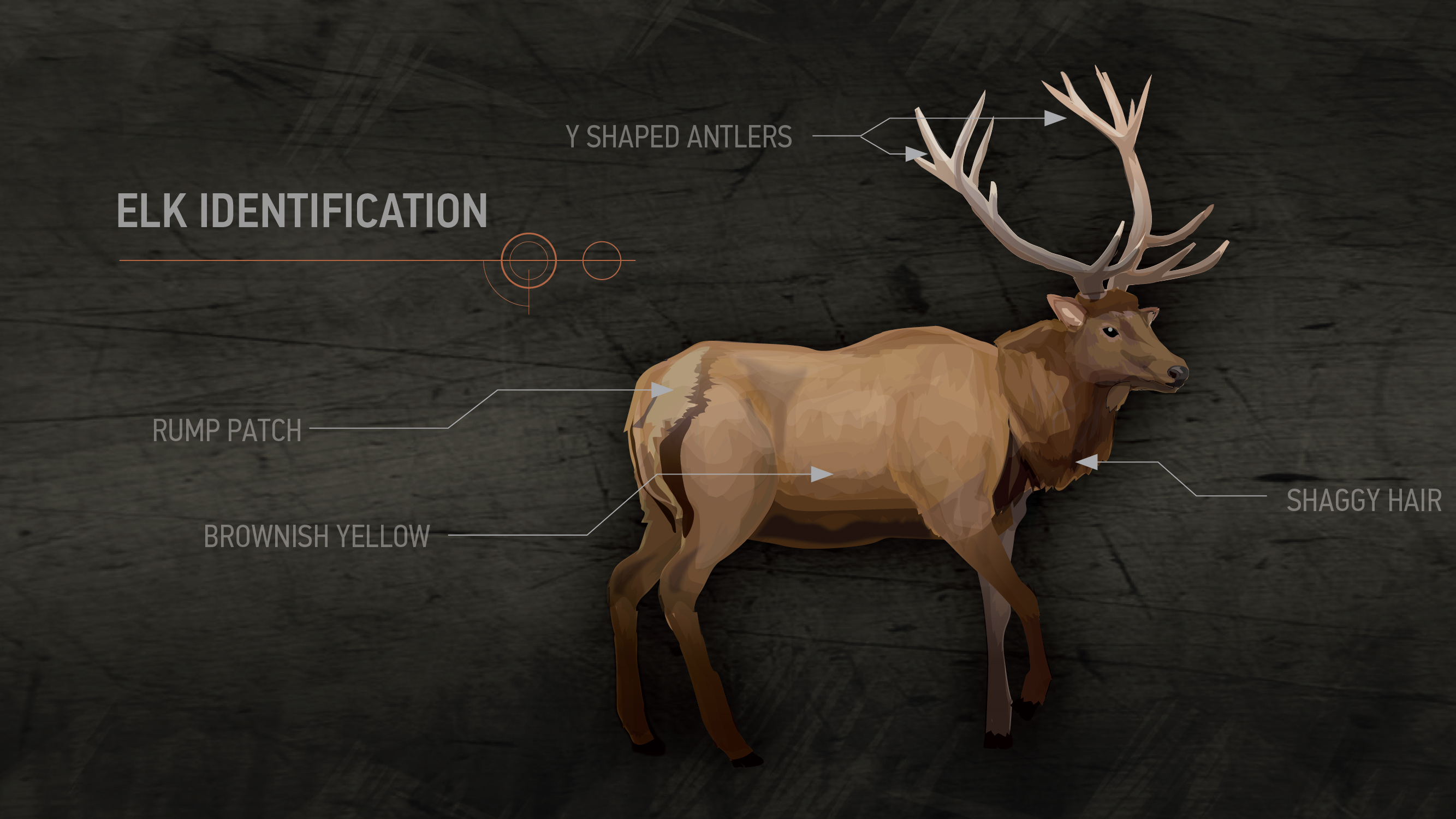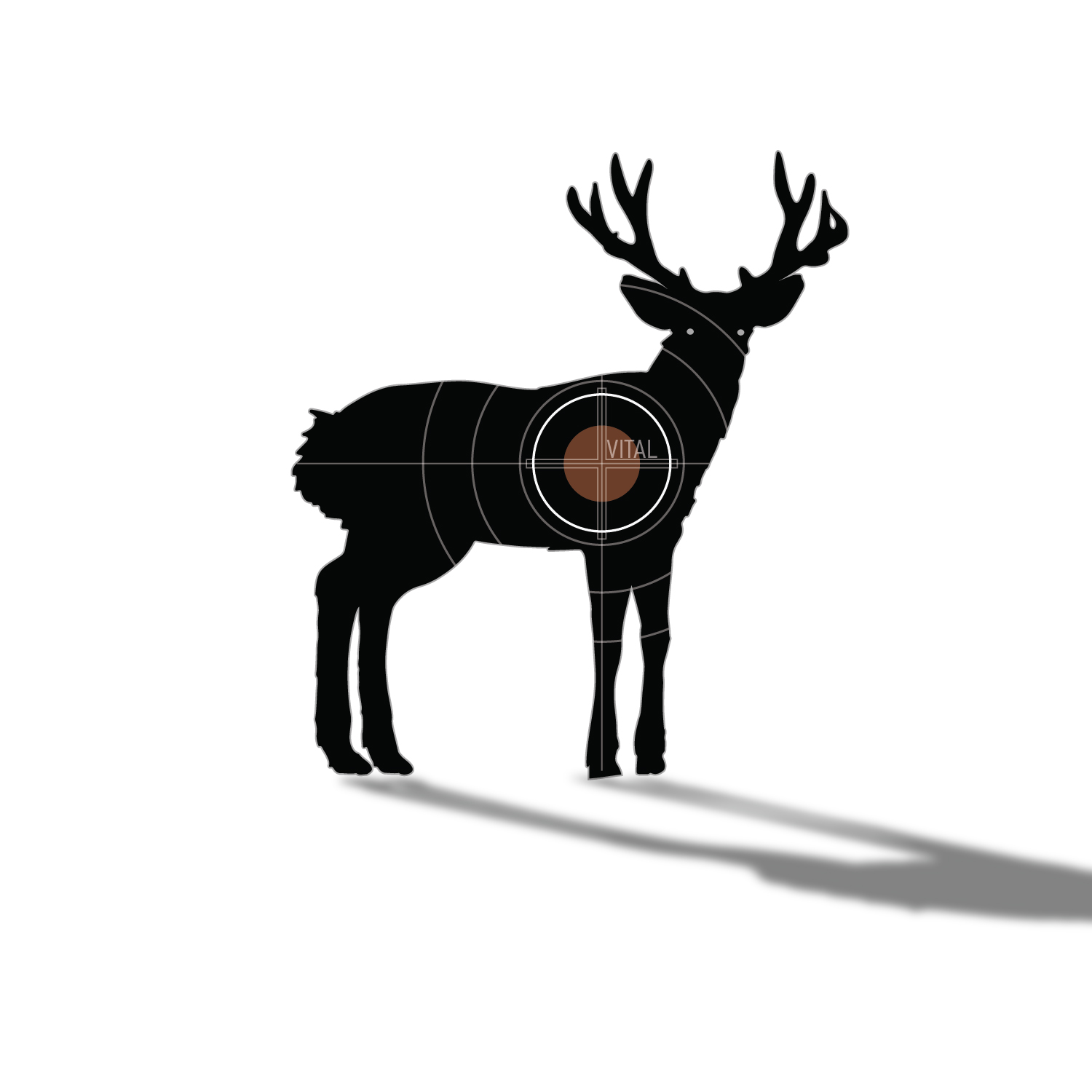HUNTINGsmart! USA Knowledge Base
Module 10 - WILDLIFE
ELK



If there was a HUGE game category—elk would be in it.
Identification
Known by some hunters as the ‘Wapiti’, elk are large game animals. Twice the size of whitetail deer, elk can weigh anywhere from 500-1000 lbs. Male elk (bulls) have distinctive antlers that fork and have a ‘Y’ shape (like the end of a whale’s tail). Typically, a full-grown bull elk will have about 5 to 7 tines projecting from each main antler branch. Female elk (cows) can be easily spotted due to their lack of antlers. They also tend to be smaller than males, weighing around 500–600 lbs. Additionally, elk fur is a brownish-yellow color and they have a yellow-ish patch on their rump. The fur under their necks is usually a little shaggier and longer than the rest of their body.
Diet
Elk are major grazers. They eat grasses and fresh vegetation that grows at ground level. In the winter months they’ll eat shrubs, twigs and bark from willow, maple, birch and cedar. Keep this in mind when planning your hunting trip. If you can locate the bull’s food source (keeping in mind the time of year), then you can find your bull.
Habitat
Elk spend their time in mountainous regions where there are grassy plains. However, they like bogs and wet swampy areas too. They’re very adaptable and can make a comfortable home for themselves all the way from the rugged terrain of the Rocky Mountains to the desert territory of the southwest.
Elk are solitary creatures that prefer to keep away from people and from other animals—they tend to seek out specific areas within their habitat and spend most of their time there. These specific or ‘prime’ areas will provide them with food, water, isolation, and lots of places to wallow. Most of the time, these guys just want to chill out on their own and roll around in the mud.
Scat
Elk scat looks a lot like a deer dropping (a pile of pellets), but they tend to be bigger and slightly longer in shape. Bulls tend to leave their droppings in a single pile, whereas cows (being multi-taskers) will walk and poop at the same time so they can spread it over a wider area. When you find it, take a good look to figure out how fresh it is. If the scat is dry, it was probably dropped a few days ago. However, if the pellets have a wet, shiny look to them, they were probably dropped between 6-12 hours ago or less… but don’t be fooled by the weather. Humidity and rain can make old scat look shiny and fresh. Look closely!
Rubs & Scrapes
Male elk rub their antlers against trees to mark their territory. Look for smaller saplings that have been destroyed by their antlers. Fresh rubs will have a shiny appearance (the sap will be coming through the bark) and will sometimes have fur entangled in them. Oh, and remember to look higher up the trunk to the 6-foot mark because elk are tall! Additionally, like deer, elk also make scrapes on the ground. These are areas which the elk scratch up and pee on to mark their territory. When looking for these markings, keep in mind that you would be much more likely to find an elk rub than an elk scrape.
Wallows
Bulls like to ‘wallow’. They dig out muddy pits to lie in and then cover themselves with mud. They wallow to cool off during hot weather, but they also create these mud pits to mark their territory. They may or may not return to a wallowing area, but if you find a fresh one, it’s a good sign that the bull may be nearby.
Beds
Elk beds are flattened areas of grass or snow. Female elk tend to bed down in groups and males tend to stay on their own. They choose heavily forested areas to bed down in during the day and they prefer to rest in open fields at night.
Elk Calls
Elk are very vocal. Buy yourself an elk call and join the conversation. Do it properly and they’ll come right to you.
The ‘Bugle’: This is a bellowing sound that becomes a squealing whistle toward the end before finally shifting to a grunt sound. Bulls make the ‘bugle’ sound when they’re trying to establish dominance and challenge other males. Make this sound to get the attention of the big boys and to filter out the weaker, smaller elk.
The ‘Chirp’: This is a chatty noise elk make when they’re being conversational with each other. Master it and you might charm them into wandering your way.
Hunting Tip:
Carry a rack with you to rattle and a decoy to take the blame for the sound. The bull will come much closer to the sound if you give him something to approach.
Firearms, Ammo & Your Target
You need a rifle with a strong action type to bring down an elk. A bolt action, lever action or semi-auto action will get the job done. However, the semi-auto will have the least amount of recoil, which will make a difference when elk hunting because you’ll need to use higher caliber ammo to bring down the elk. You’ll feel the punch this firearm/ammo combo will deliver. Despite the recoil factor, many elk hunters actually prefer a bolt action rifle for its reliability and overall strength. Cartridges that can be used for bear or deer hunting (the best for packing the punch needed for deep penetration) will also kill an elk quickly and cleanly.
Bowhunting? An accurate shot with a compound bow or crossbow and sharp broadhead arrows will do the job.
Vital Zones

An elk’s vital spot is the lungs and heart, which is actually a fairly large target area. Go for a ‘broadside shot’ or ‘quartering away shot’ and land it right behind the shoulder. Never aim for the head or neck—this unethical shot placement would badly injure an elk but not kill it quickly.
Your Best Shot:
The ‘quartering away’ shot is your best shot opportunity for elk. This is when the elk is facing away from you at about a 45° angle and is stepping slightly forward. This exposes the vital zone area that is covered by the shoulder blade when the elk is standing still. An accurate ‘quartering away’ shot will hit the shoulder and chest area and either drop the elk immediately or cause enough internal bleeding that you’ll have a blood trail that's easy to follow.



